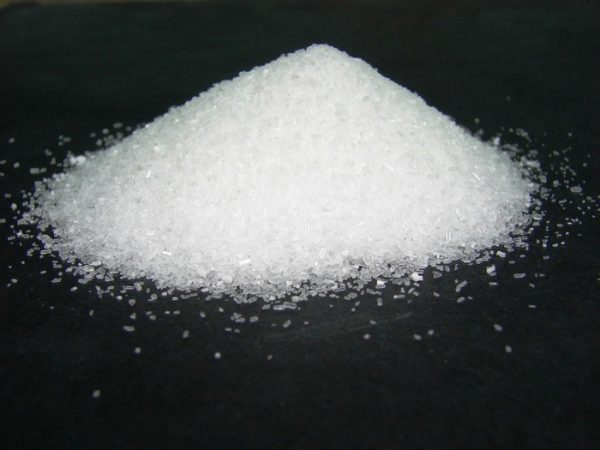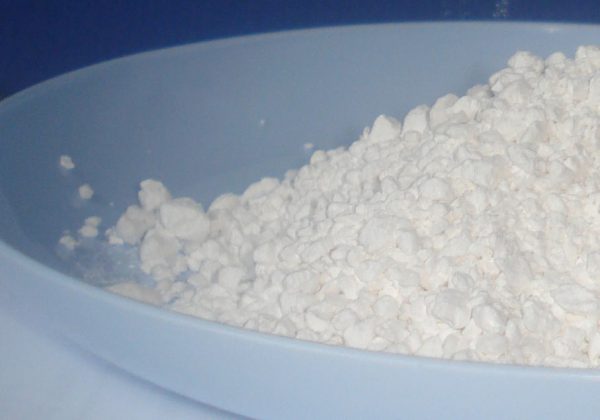Fertilizer magnesium sulfate: application and benefits of the product
Content
Benefits of the tool
With long-term cultivation of even the richest soil, microelements from it are gradually selected by plants, they must be replenished, otherwise you can completely lose the crop. The complex mineral fertilizer magnesium sulfate contains 17% magnesium, 13% sulfur and an insignificant amount of all other elements; its other names are also used - magnesia or English (bitter) salt. Fertilizer is produced in the form of a white or slightly grayish crystalline powder. It dissolves well in water, faster in warm water. It is easy to store it, you can even open it, the main thing is to protect it from moisture and the sun. It does not cake, is transported without problems, and does not change its characteristics during long-term storage.
The use of magnesium sulfate affects the whole plant, fertilization does not allow oxidative processes to develop, but helps to accumulate essential oils, other elements important for ripening. Thanks to it, the amount of ascorbic acid and sugars increases. Magnesium has the ability to move around the plant, it moves from old parts to new ones - where the need arises. Its deficiency makes the leaves lighter or brownish between the veins, which glow green against an incorrectly colored background.
First, old leaves dry up, become brittle (usually the lower ones), then the plant loses all foliage and dies. To prevent this from happening in the garden, it is necessary to use complex inorganic fertilizers. Magnesium sulfate will significantly enrich the soil with the necessary trace elements, and there will be benefits for the coming years. It is very important that the plant will never be oversaturated with magnesium, it will take exactly as much as it needs, and the excess will remain in the soil and will benefit the next plantings.
Video "How the substance is made"
Video review on the production of a substance.
What can be combined with
The fertilizer works successfully on all soils without exception. It is especially effective on light sandy soils. Acidic soils interfere with the absorption of magnesium by plants, so you should pay special attention to them. Usually magnesium sulfate is applied in the spring, and acidic soils are recommended to be deoxidized first with lime, which is introduced into the soil in the fall, digging up the vacant garden. Epsom salts usually work well with other mineral fertilizers, especially those containing nitrogen and phosphorus. Its use together with potassium sulfate not only enriches the fruits of vegetable and horticultural crops, but helps the growth of indoor flowers. Lovers of indoor plants feed their plantings with these two salts in order to avoid yellowing of the leaves, to achieve excellent flowering.
In the garden, magnesia is very often used together with other mineral fertilizers. For example, it is good to feed tomatoes with such a composition: calcium nitrate, potassium nitrate, magnesium sulfate, monopotassium phosphate, potassium sulfate, ammonium nitrate.It should be borne in mind that a large amount of magnesium sulfate can reduce the amount of calcium, which will have a negative effect on the growth of crops - and therefore it is also better to use a whole range of fertilizers.
Instructions for use
Magnesia, together with nitrogen and phosphorus fertilizers, is applied to the soil in spring, when the soil is prepared for seedlings. For tomatoes and cucumbers, 7-10 g per sq. m, for other vegetables (and flowers) a little more - 12 - 15 g per sq. m. Moreover, you can simply add dry powder - it dissolves perfectly after rain or watering. For potatoes, 15 - 20 g per sq. m. When feeding root crops, it is advisable to place the powder on the same level with them.
The trees are fed in this way: a shallow ditch is dug around the trunk, magnesia is poured at the rate of 30 - 35 g per sq. m, cover with earth. Fall dressing makes it easier for garden crops to overwinter. In addition, root (stimulates growth and nourishes the plant) and foliar (magnesium is perfectly absorbed by all parts of the plants) feeding during the entire growing season. So for a tree, you can make a solution (25 g per 10 liters of water) and water a young tree with 5 liters, and for an adult you need all 10 liters. For sprinkling greens, 10 g are diluted in 10 liters.
When planting fruit shrubs, 20 - 25 g of fertilizer are placed under the root once, root top dressing is done by watering at a time with 2 - 3 liters of solution made at the rate of 15 g of Epsom salt per 10 liters of water. Cabbage, carrots, beets during active growth are watered twice a month with 35 g of magnesia diluted with 10 liters of warm water. If you need to spray, then for 10 liters of water take 20 g of fertilizer. Cucumbers and tomatoes are also watered with diluted fertilizer 2 times a month (30 g - per 10 liters of water), and sprayed with a solution of 15 g - per 10 liters of water. Dry periods lead to magnesium deficiency, so in hot dry summers watering must be combined with root dressing.
Video "Using a similar substance for plants"
This video describes the use of a similar substance to fertilize plants.




